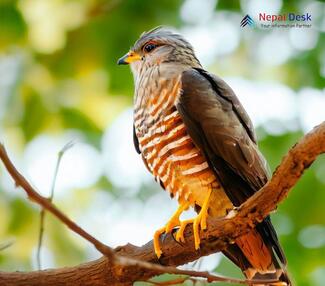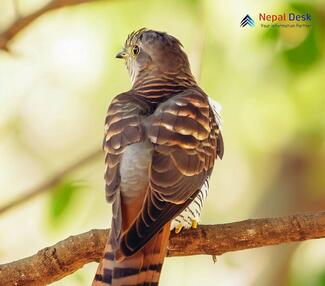The bird-watching community has always been fascinated by the diverse avifauna of Nepal. One such intriguing species that captures the attention of bird enthusiasts is the Large Hawk Cuckoo (Hierococcyx sparverioides). Its striking appearance, impressive vocalizations, and secretive nature make it a truly captivating creature. In this article, we will delve into some fascinating details about this remarkable bird, and its presence in Nepal, and reveal an interesting fun fact about its behavior.
Diving into the Bird Details
The Large Hawk Cuckoo is a medium-sized bird that belongs to the family Cuculidae. With a body length ranging from 39 to 44 cm, this deceptive bird of prey resembles smaller hawks and sparrowhawks. The resemblance is quite intentional, as it serves as an effective tactic for evading potential predators and allowing the cuckoo to hunt more efficiently. It has a distinctive barred underside with greyish-brown upper parts and a long tail with several dark bars.
Vocalizations play a significant role in the lives of these birds. They are characterized by a loud and repetitive song that sounds like ‘brain fever,’ which is often heard during the breeding season. This unique vocalization allows them to communicate with one another and assert their territories.
Presence in Nepal
Nepal's diverse landscape serves as an ideal habitat for numerous bird species, including the Large Hawk Cuckoo. It favors dense forests, woodlands, and forest edges situated in subtropical and temperate zones. This amazing bird can be found throughout the country – from lowland Terai regions to hilly areas up to 2,500 meters above sea level.
Migration patterns vary among individuals, but generally speaking, Nepalese populations of this species are considered resident or altitudinal migrants. During the cold winter months, they move to lower elevations in search of suitable habitats and prey availability.
A Fun Fact: The Brood Parasites
An interesting characteristic of the Large Hawk Cuckoo is its breeding behavior. Like many other cuckoo species, it does not build its own nest but instead engages in brood parasitism. The female lays her eggs in the nests of other bird species, leaving the unwitting foster parents to care for her offspring. Once hatched, the cuckoo chick instinctually eliminates competition by pushing the host's eggs or hatchlings out of the nest.
In conclusion, the Large Hawk Cuckoo stands as a fascinating and enigmatic bird species present in Nepal. Its hawk-like appearance, distinctive vocalizations, and intriguing reproductive behavior all contribute to making it a wonderful subject for bird watchers and wildlife enthusiasts alike. So, next time you explore the lush forests of Nepal, keep an ear out for the unique call of this captivating bird and get a glimpse into its secretive world!




